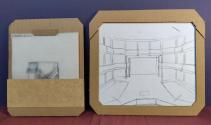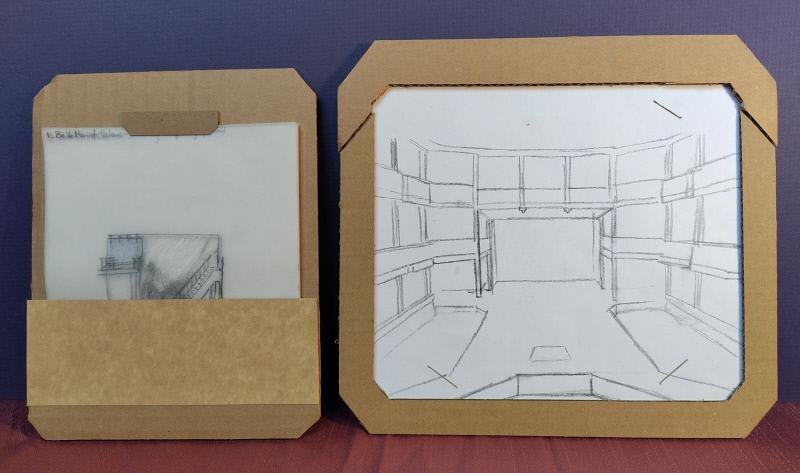An Imagined Theatre Design for the Swan Theatre - Storyboard
Collection:UAL Art Collection
Date: 2024
Artist: V Hayward (British)
Dimensions:
15 x18.5 x 0.5cm (slide holder, holding 12 tracing paper slides) and 20 x 21.5 x 0.8cm (theatre background board)
Medium: Cardboard, tracing paper, graphite pencil
Object number: UAC 1148
DescriptionV studied MA Theatre and Performance Design at Wimbledon College of Arts. They say: 'This work was made for my final project of my MA in Theatre and Performance Design and is part of a theatre design (set, puppetry and costume) for an imagined play at the Royal Shakespeare Company’s Swan Theatre inspired by Kate Atkinson’s novel Life After Life. Sustainability and ecological thought impact heavily on my designs, shaping the materials I use and the designs I create, with each decision weighed according to its material and carbon cost as well as its practicality and financial cost. By designing based on existing set pieces and embracing sustainable aesthetics that call for focussed material use, I have minimised the design’s environmental impact while amplifying its theatrical power.
A storyboard is an important tool in communicating about the set to the company of a production. It highlights key moments when actors and set interact with each other, sometimes including lighting states and stage directions too. This storyboard is made with tracing paper slides that can each be placed in the theatre background board, made of corrugated cardboard, to show how each moment would look on the RSC’s Swan Theatre stage. The slides can also be viewed independently to see which elements of the stage change from one scene to the next. Although storyboards are often digital, I prefer this way of showing the set changes as it feels more dynamic and interactive, allowing particularly the actors to play with ideas and possibilities'.
A storyboard is an important tool in communicating about the set to the company of a production. It highlights key moments when actors and set interact with each other, sometimes including lighting states and stage directions too. This storyboard is made with tracing paper slides that can each be placed in the theatre background board, made of corrugated cardboard, to show how each moment would look on the RSC’s Swan Theatre stage. The slides can also be viewed independently to see which elements of the stage change from one scene to the next. Although storyboards are often digital, I prefer this way of showing the set changes as it feels more dynamic and interactive, allowing particularly the actors to play with ideas and possibilities'.







